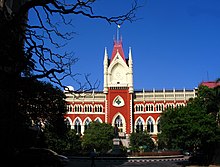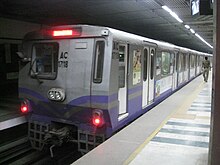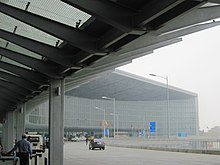Bengali Wikipedia 10th Anniversary Celebration Kolkata/City and Conference
| Main page | City and Conference | Venue | Community & Team | Logistics | Programs | Registration | Scholarship | Call for Participation | Sponsors | FAQ |
Kolkata
[edit]
Kolkata on Wikipedia: (English, Afrikaans, مومباي, কলকাতা, Català, Česky, Deutsch, Ελληνικά, Esperanto, Español, فارسی, Français, हिन्दी,Hebrew, Italiano, Malayalam, Polski, Português)
Kolkata (কলকাতা), formerly known as Calcutta, is the capital of the Indian state of West Bengal. Located on the east bank of the Hooghly River, it was once the commercial capital of eastern India. The city proper has 4.5 million residents, and the metropolitan area, including suburbs, has a population of approximately 14.2 million, making it the third-most populous metropolitan area in India and the 13th-most populous urban area in the world. Kolkata is also classified as the eighth-largest urban agglomeration in the world.
Kolkata served as the capital of India during the British Raj until 1911, when its perceived geographical disadvantages and a growing nationalism in Bengal led officials to shift the capital to New Delhi. The city is noted for its vibrant political culture. It was a center of the Indian struggle for independence and remains a hotbed of contemporary politics. Once the center of modern education, science, culture, and politics in India, Kolkata witnessed economic stagnation in the years following India's independence in 1947. However in post-liberalization India, economic rejuvenation has led to an acceleration in the city's growth. Like other metropolitan cities in developing countries, Kolkata continues to deal with contemporary urban problems like pollution and traffic congestion. Despite such problems, it remains the dominant urban area of eastern India and the major economic, educational and cultural hub.
Culture
[edit]

Kolkata has long been known for its literary, artistic and revolutionary heritage. As the former capital of India, Kolkata was the birthplace of modern Indian literary and artistic thought. Kolkatans tend to have a special appreciation for art and literature; its tradition of welcoming new talent has made it a City of Furious Creative Energy. For these reasons, Kolkata has often been dubbed as the Cultural Capital of India or the Literary Capital of India.
A characteristic feature of Kolkata is with the para or neighbourhoods having a strong sense of community. Typically, every para has its own community club with a clubroom and often, a playing field. People here habitually indulge in adda, or leisurely chat, and these adda sessions are often a form of freestyle intellectual conversation. The city has a tradition of political graffiti depicting everything from outrageous slander to witty banter and limericks, caricatures to propaganda.
The city has a tradition of dramas in the form of jatra (a kind of folk-theatre), theatres and Group Theaters. Kolkata is the home of the Bengali cinema industry, dubbed "Tollywood" after Tollygunj, the location of Bengali movie studios. Its long tradition of Art-Film making includes globally acclaimed directors such as Academy Award winning director Satyajit Ray, Ritwik Ghatak, Mrinal Sen,Tapan Sinha and contemporary directors such as Aparna Sen, Buddhadeb Dasgupta and Rituparno Ghosh.

In the nineteenth and twentieth century, Bengali literature was modernized in the works of authors such as Ishwar Chandra Vidyasagar,Bankim Chandra Chattopadhyay, Michael Madhusudan Dutt, Rabindranath Tagore, Kazi Nazrul Islam and Sarat Chandra Chattopadhyay. This literary modernization, coupled with the social reforms led by reformers like Ram Mohan Roy, Iswar Chandra Vidyasagar, Swami Vivekananda and others, constituted a major part of the Bengal Renaissance . The rich literary tradition set by these authors has been carried forward in the works ofJibanananda Das, Bibhutibhushan Bandopadhyay, Tarashankar Bandopadhyay,Manik Bandopadhyay,Ashapurna Devi, Shirshendu Mukhopadhyay, Buddhadeb Guha, Mahashweta Devi, Samaresh Majumdar,Sanjeev Chattopadhyay and Sunil Gangopadhyay among others.
Kolkata is also an important centre of art and has hosted many important artists like Abanindranath Tagore, Jamini Roy, Ram Kinker Baij, Bikash Bhattacharya, Paresh Maity and Devajyoti Ray. In the 1960s, the city has seen the emergence of the famous Calcutta Group, which preceded the Progressive Artists Group in field of modern Indian art. In 2005, the first exhibition on Pseudorealism was held at the Birla Academy of Art and Culture. The city continues to be the home of one of the most passionate lovers of art in country. Kolkata is often also called the backyard of Indian art.

The city is also noted for its appreciation of Rabindrasangeet and Indian classical music as well as Bengali folk music such asbaul and kirtans and gajan, and modern songs including Bengali adhunik songs. From the early 1990s, there has been an emergence of new genres| of music, including the emergence of what has been called Bengali Jeebonmukhi Gaan (a modern genre based on realism).
Key elements of Kolkata's cuisine include rice and Machher jhol (fish curry), with roshogolla, sandesh and mishti dohi(sweet yoghurt) as dessert. Bengal's vast repertoire of fish-based dishes includes various eelish preparations (a favorite among Bengalis). Street foods such as beguni (fried battered eggplant slices), kati roll (flatbread roll with vegetable or chicken,mutton, or egg stuffing), phuchka (deep fried crêpe with tamarind and lentil sauce) and Indian Chinese cuisine fromChina Town in the eastern parts of the city are quite popular. Sweets occupy an important place in the diet of Kolkatans and at their social ceremonies.
Bengali women commonly wear the shaŗi as per tradition and global/western outfits. Among men, western dressing has greater acceptance, though the traditional dhoti and panjabi/kurta comes to life on festivals.
Durga Puja, in the autumn, is the most important festival and the most glamorous event in Kolkata. Other notable festivals includeJagaddhatri Puja, Diwali, Saraswati puja, Eid, Holi, Christmas,poila boishak (new year), Rath Yatra and Poush parbon (harvest festival). Some of the cultural festivals are Kolkata Book Fair, Dover Lane music festival, Kolkata Film Festival and National Theatre Festival.
Sightseeing
[edit]Kolkata, India, has been nicknamed the City of Palaces and also the City of Joy. City of Palaces comes from the numerous palatial mansions built all over the city and City of Joy comes from the lively and friendly and loving behavior of all the citizens all over the places making the city more lively and enjoyable. During the British colonial era from 1700 to 1912, when Kolkata (then known as Calcutta) was the capital of British India, Kolkata witnessed a spate of frenzied construction activity of buildings largely influenced by the conscious intermingling of Neo-Gothic, Baroque, Neo-Classical, Oriental and Islamic schools of design. Unlike many north Indian cities, whose construction stresses minimalism, the layout of much of the architectural variety in Kolkata owes its origins to European styles and tastes imported by the British and, to a much lesser extent, the Portuguese and French. The buildings were designed and inspired by the tastes of the English gentleman around and the aspiring Bengali Babu (literally, a nouveau riche Bengali who aspired to cultivation of English etiquette, manners and custom, as such practices were favourable to monetary gains from the British). Today, many of these structures are in various stages of decay. Some of the major buildings of this period are well maintained and several buildings have been declared as heritage structures. Conservation efforts are patchy and are often affected by problems of litigation, tenant troubles, ownership disputes, old tenancy laws and a lack of funds.
Museums & Libraries
[edit]- Victoria Memorial was Lord Curzon's brainchild as a memorial to the Empress of India and Queen of the United Kingdom, Queen Victoria after her death in 1901, the Victoria Memorial was modelled on the Taj Mahal and was commissioned in 1906. Opened to the public in 1921, it was designed by the architects William Emerson and his protege Vincent Esch at the extraordinary cost of Rupees 10.5 million ($262,500), all of which was collected as voluntary donations, mostly from the British and Indian nobility.
- The Indian Museum is the largest museum in Asia and the oldest in the Asia - Pacific region (est. 1814 at the location of the Asiatic Society). The Museum shifted to its present sprawling residence in 1875. Situated on Chowringhee Avenue (now J.L. Nehru Road), it houses perhaps the greatest collection of Indian natural history and an Indian Art collection to rival the Smithsonian Institution and the British Museum.
- The Marble Palace is a privately owned collection of eclectic sculptures, paintings and a small menagerie and aviary off Chittaranjan Avenue in North Kolkata. Built by Raja Rajendra Mullick in 1835, it houses, among other treasures two little-publicized Reubens and a Joshua Reynolds, not to mention over 50 varieties of marble which grace the interiors of this mansion.
- Birla Industrial & Technological Museum on Gurusaday Dutta Road, was inaugurated in 1959 as the first popular science museum in Asia. Modelled on the Deutsches Museum, it has interactive popular science exhibits and a significant collection of historical industrial holdings in India. Its collection of old gramophones, sound recorders, telephones, steam engines, road rollers and other industrial machinery of the period 1880–1950 is very significant.
- Science City is a complex near the Eastern Metropolitan Bypass featuring a lot of interactive science and live bioscience exhibits, as well as having Kolkata's first OMNIMAX theatre.
- The Jorasanko Thakur Bari is the ancestral home of the Tagore family and was converted into a museum in 1961. The huge sprawling brick mansions were the cultural hub of Kolkata for close to a century and was a major force in the women's liberation movement. It hosted the first Brahmo wedding and was an important center in the Independence movement.
- Gurusaday Museum, on Diamond Harbour Road, is the outcome of a lifetime of collection of traditional Bengal folk arts in undivided Bengal by Sir Gurusaday Dutt. On his death in 1941, the collection was handed over to the Bratachari Society founded by Sir Gurusaday Dutt to preserve and protect Bengal folk arts. It was opened as a museum to the public with the help of the Government of India in 1963.
- Jawahar Shishu Bhavan is named after Jawaharlal Nehru, whose love for children was well known. The museum has a collection of dolls and toys from across the globe, and has a doll - based retelling of the Indian epics Ramayana and Mahabharata. Established in 1972 close to the Victoria Memorial, and commonly referred to as "Nehru Children's Museum", this museum is aging awkwardly fast.
- Sabarna Sangrahashala located at Baro Bari, Barisha, Kolkata 700008, is the only family museum of Kolkata which is open to public. It was established in 2005 by the Sabarna Roy Choudhury Paribar Parishad and already has become a great tourist destination specially for those who want to know more about the history of Kolkata. It is also a research institute in the making. The Museum possesses some of the rarest Kabulatipatras, documents and articles of historical importance. The museum is dedicated to students for creating an awareness in history and culture.
- National Library of India located in Alipore is India's leading library and a public library. It was inaugurated in 1836 by the Governor General Lord Metcalfe by transferring 4675 books from the College of Fort William. Public donations were the main source of books for the library, and by donations of Rupees 300 from proprietors. Dwarakanath Tagore was the first proprietor of the library. The library was initially only partially public, as poor students could use the library for a limited period of time.
- Kolkata also has some other small museums like the Maritime Museum, and the Police Museum.
- The other popular Kolkata libraries include the Ramakrishna Mission Library, maintained by the Ramakrishna Mission, Kolkata which has a special children's section, as well as the large consulate-based libraries of British Council, Kolkata and of the United States Information Service, Kolkata. The Calcutta Club library has a historically significant collection, including the fully furnished and book-stocked reading room of Nirad C. Chaudhuri. The other historically significant libraries are those of Asiatic Society, Indian Museum, Presidency College, Scottish Church College, and St. Xavier's College, Calcutta.
British administrative offices
[edit] |
 |
 |
 |
- Calcutta High Court - It is the oldest High Court in India.
- Raj Bhavan (Government House) - It was built in the early 19th century, is modelled on Kedleston Hall.
- Town Hall - In Roman-Doric style, this building was built by the architect Col. John Garstin in 1813 with a fund of Rupees seven lakhs raised from lottery to provide the Europeans with a place for social gatherings.
- Writers' Building - It is the secretariat building of the State Government of West Bengal in India.
- General Post Office - It is the central post office of the city of Kolkata, India and the chief post office of West Bengal. The post-office handles most of the city's inbound and outbound mail and parcels. Situated in the B.B.D. Bagh area, the imposing structure of the GPO is one of the landmarks in the city.
- Esplanade Mansions
- South Eastern Railway Headquarters, Garden Reach
- Howrah station - It is one of the four intercity train stations serving Howrah and Kolkata, India; the others are Sealdah Station, Shalimar Station and Kolkata railway station in Kolkata. Howrah is situated on the West bank of the Hooghly River, linked to Kolkata by the magnificent Howrah Bridge which is an icon of Kolkata. It is the oldest station and the largest railway complex in India.
Transport
[edit]


Public transport is provided by the Kolkata Suburban Railway, the Kolkata Metro, trams, and buses. The suburban rail network reaches the city's distant suburbs. According to a 2013 survey conducted by International Association of Public Transport, Kolkata ranks the top among the six cities surveyed in India, in terms of public transport system.
Kolkata has rail and road connectivity with Dhaka, capital of Bangladesh.
Buses, which are the most commonly used mode of transport, are run by government agencies and private operators. Kolkata is the only Indian city with a tram network, which is operated by the Calcutta Tramways Company. Water-logging, caused by heavy rains that fall during the summer monsoon, can interrupt transportation networks. Hired public conveyances include auto rickshaws, which often ply specific routes, and yellow metered taxis. Almost all of Kolkata's taxis are antiquated Hindustan Ambassadors by make; newer air-conditioned radio taxis are also in service.
Due to its diverse and abundant public transportation, privately owned vehicles are not as common in Kolkata as in other major Indian cities. The Kolkata Metro has somewhat eased traffic congestion, as has the addition of new roads and flyovers. Agencies operating long-distance bus services include Calcutta State Transport Corporation, South Bengal State Transport Corporation, North Bengal State Transport Corporation, and various private operators. The city's main bus terminals are located at Esplanade, Karunamoyee, and Babughat. The Kolkata–Delhi and Kolkata–Chennai prongs of the Golden Quadrilateral, and National Highway 34 start from the city.
Netaji Subhas Chandra Bose International Airport, located in Dum Dum some 16 km (9.9 mi) north-east of the city centre, operates domestic and international flights. In 2013, the airport was upgraded to handle increased air traffic. The Port of Kolkata, established in 1870, is India's oldest and the only major river port. The Kolkata Port Trust manages docks in Kolkata and Haldia.
Wi-fi
[edit]Wifi will be provided at the venue at no extra cost to the attendees.
Google Maps
[edit]Registration
[edit]For Registration: Click here to register
Venue
[edit]For details and how to reach venue see Bengali Wikipedia 10th Anniversary Celebration Kolkata/Venue
Scheduled program
[edit]For Program Details see here: Programme.
For emergency
[edit]Kolkata Police
- Phone: 100/1090
- http://www.kolkatapolice.gov.in/ContactUs.aspx http://www.kolkatapolice.gov.in/HelpLine.aspx
Hospital
Ambulance
